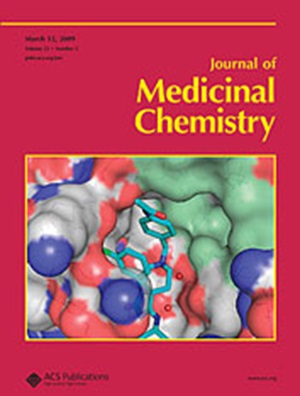靶向降解PD-L1蛋白的dna介导溶酶体降解策略。
IF 6.8
1区 医学
Q1 CHEMISTRY, MEDICINAL
引用次数: 0
摘要
程序性细胞死亡配体1 (PD-L1)的表达使肿瘤细胞能够逃避t细胞的免疫监视。细胞表面的PD-L1水平对PD-L1靶向免疫检查点阻断治疗的有效性起着至关重要的作用。因此,我们利用清道夫受体(SRs)独特的运输能力,将PD-L1引导到溶酶体进行降解。通过点击化学将PD-L1抑制剂BMS-202与树突状DNA支架结合,我们创造了一种双功能化合物PBL1,它能够同时靶向SRs和PD-L1。PBL1在体内和体外均能有效诱导PD-L1降解,显著降低传统PD-L1抑制剂的脱靶毒性。PBL1的有效性和特异性已在A549细胞和斑马鱼模型中得到验证。这种srs介导的溶酶体降解策略的发展为癌症免疫治疗提供了一种有希望的新方法,为现有的PD-L1抑制剂提供了一种更安全、更有针对性的替代方案。本文章由计算机程序翻译,如有差异,请以英文原文为准。
A DNA-Mediated Lysosomal Degradation Strategy for Targeted Degradation of PD-L1 Protein.
The expression of programmed cell death ligand 1 (PD-L1) enables tumor cells to evade immune surveillance by T-cells. The level of PD-L1 on the cell surface plays a crucial role in the effectiveness of PD-L1-targeted immune checkpoint blockade therapy. Therefore, we utilized the unique trafficking capabilities of scavenger receptors (SRs) to direct PD-L1 to lysosomes for degradation. By employing click chemistry to conjugate the PD-L1 inhibitor BMS-202 with dendritic DNA scaffolds, we created a bifunctional compound, PBL1, which is capable of simultaneously targeting both SRs and PD-L1. PBL1 effectively induces PD-L1 degradation both in vitro and in vivo, significantly reducing the off-target toxicity commonly associated with traditional PD-L1 inhibitors. The efficacy and specificity of PBL1 have been validated in A549 cells and zebrafish models. The development of this SRs-mediated lysosomal degradation strategy offers a promising new approach for cancer immunotherapy, providing a safer and more targeted alternative to existing PD-L1 inhibitors.
求助全文
通过发布文献求助,成功后即可免费获取论文全文。
去求助
来源期刊

Journal of Medicinal Chemistry
医学-医药化学
CiteScore
4.00
自引率
11.00%
发文量
804
审稿时长
1.9 months
期刊介绍:
The Journal of Medicinal Chemistry is a prestigious biweekly peer-reviewed publication that focuses on the multifaceted field of medicinal chemistry. Since its inception in 1959 as the Journal of Medicinal and Pharmaceutical Chemistry, it has evolved to become a cornerstone in the dissemination of research findings related to the design, synthesis, and development of therapeutic agents.
The Journal of Medicinal Chemistry is recognized for its significant impact in the scientific community, as evidenced by its 2022 impact factor of 7.3. This metric reflects the journal's influence and the importance of its content in shaping the future of drug discovery and development. The journal serves as a vital resource for chemists, pharmacologists, and other researchers interested in the molecular mechanisms of drug action and the optimization of therapeutic compounds.
 求助内容:
求助内容: 应助结果提醒方式:
应助结果提醒方式:


